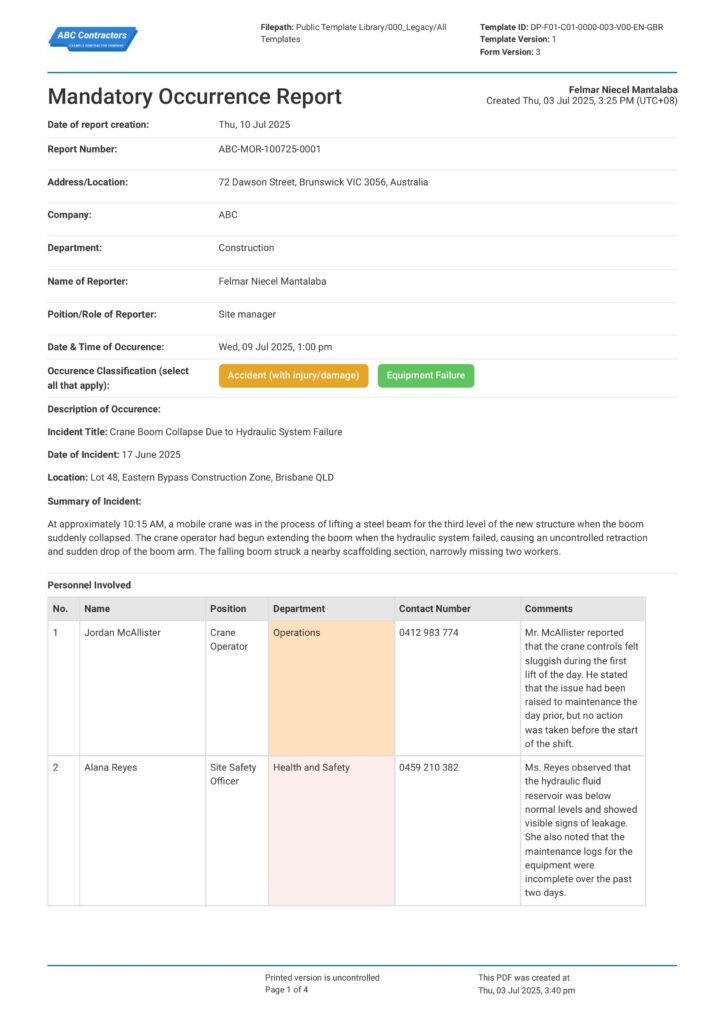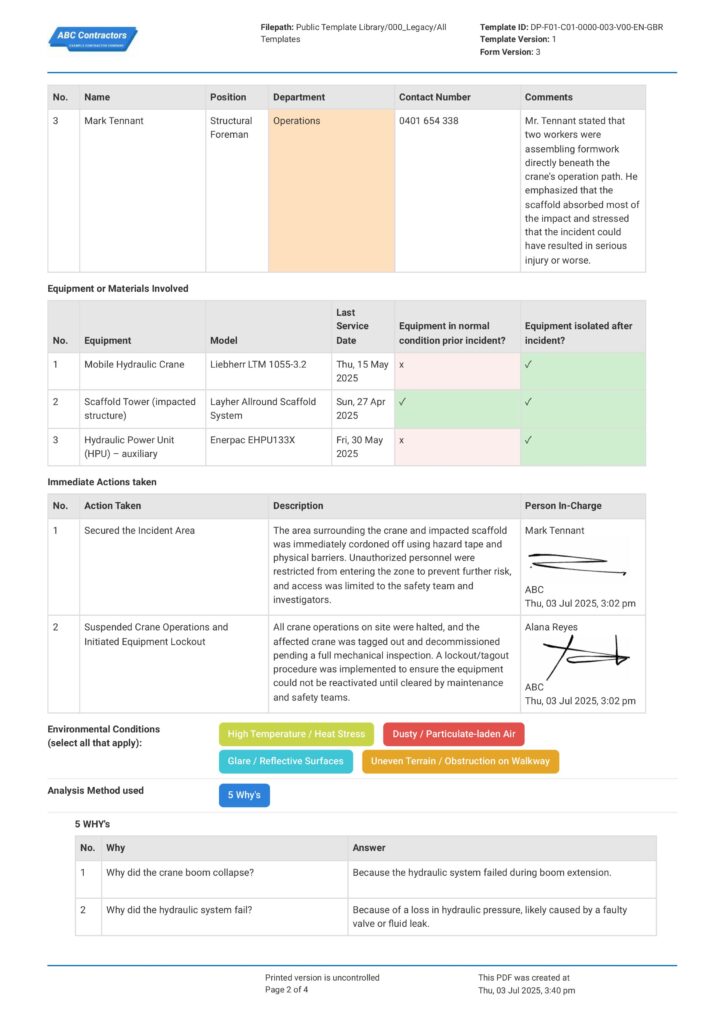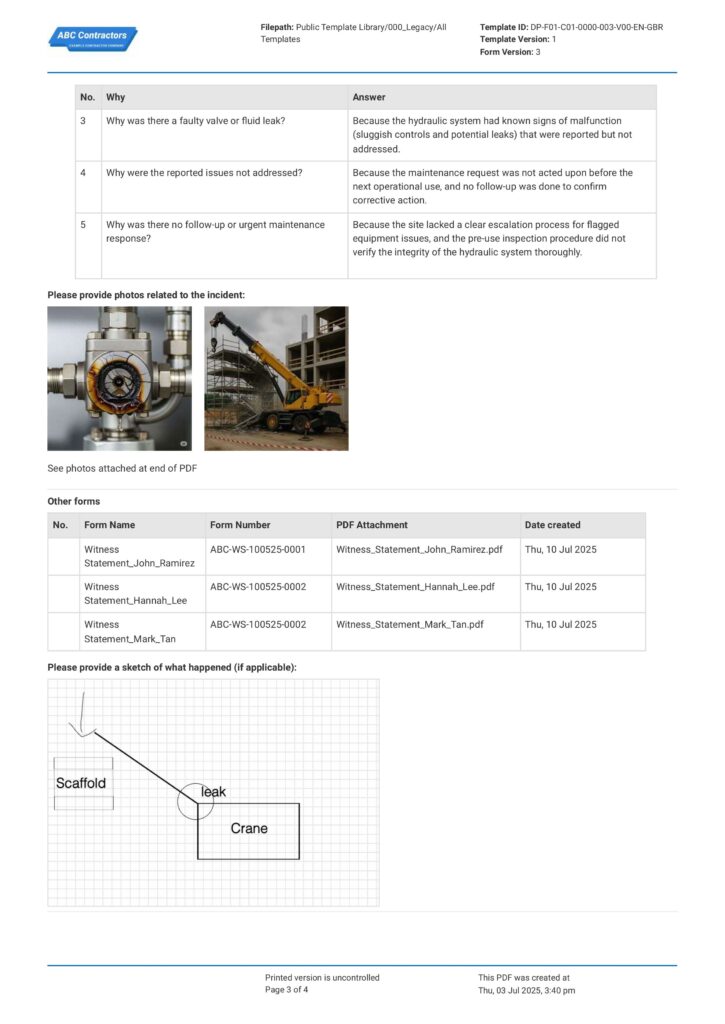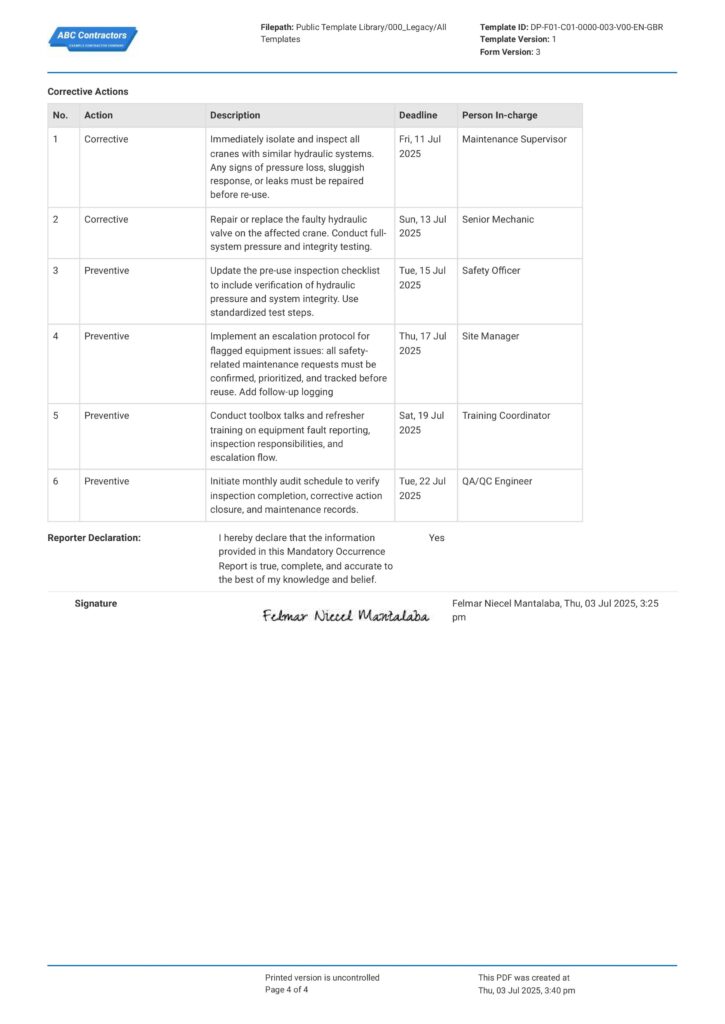Mandatory Occurrence Report Template
Start with a free 30-day trial. No credit card required.
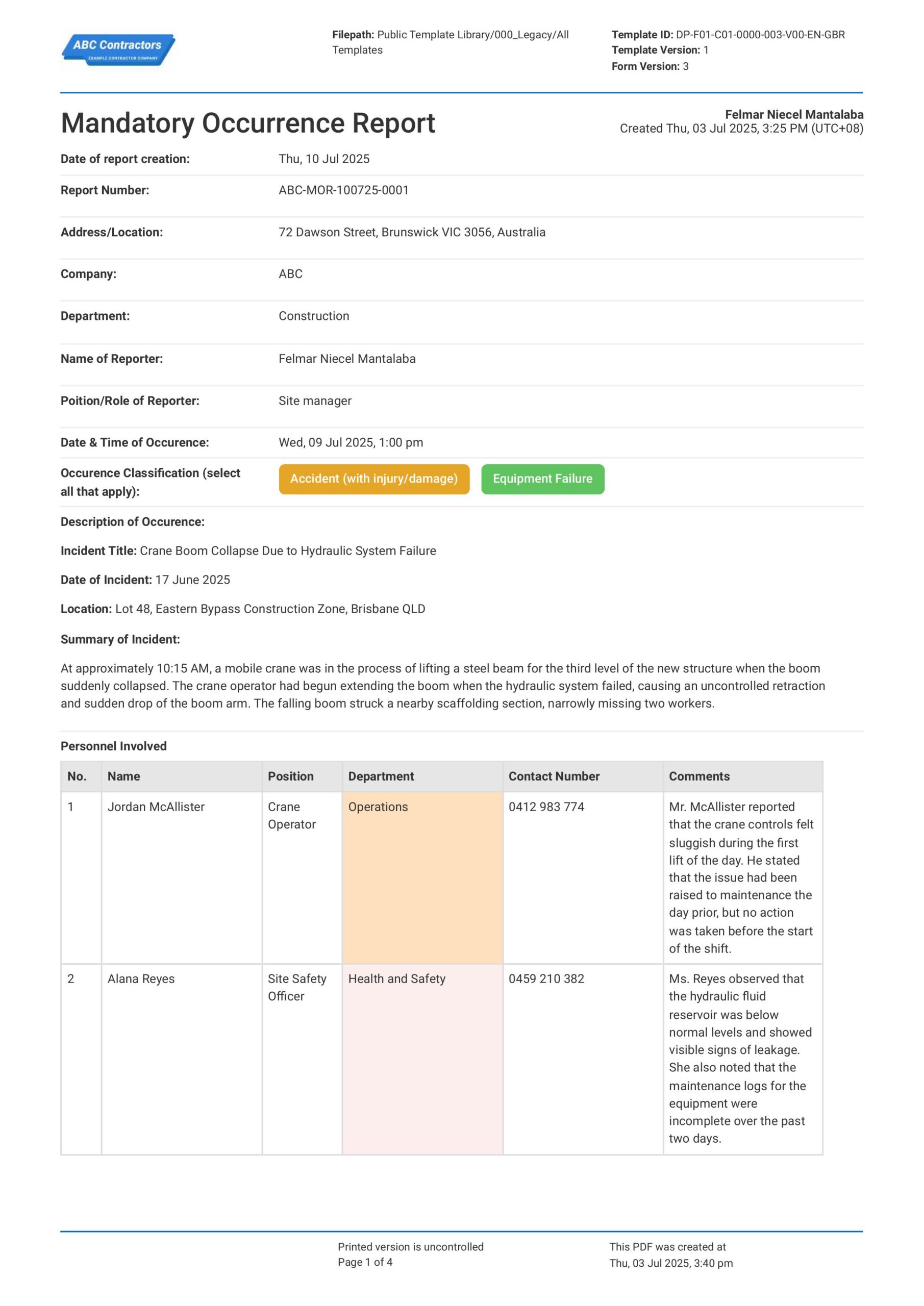
~10,000 employees
~10 employees
~200 employees
~25,000 employees
~1,000 employees
~1,500 employees
~30 employees
What is a Mandatory Occurrence Report?
A Mandatory Occurrence Report (MOR) is a document required by the Building Safety Act. Its purpose is to increase accountability and transparency in the UK's construction and management of higher-risk buildings. Under this act, duty holders—such as building owners, developers, and managers—are required to inform the Building Safety Regulator of any accidents or occurrences related to safety.
Adhering to this regulation ensures that building safety is continuously improved, hazards are controlled, and a strong responsibility is placed on dutyholders to make sure that a building is always safe and sound.
Compare this mandatory reporting form to document forms created from Word, Excel, or PDF
Use this Mandatory Occurrence Report template for free.
Why is Mandatory Occurrence Reporting required?
A Mandatory Occurrence Report (MOR) is necessary for various reasons, all rooted in making sure that safety is continuously maintained in the workplace—especially in high-risk work environments like construction. The following section outlines the critical need for a Mandatory Occurrence Report (MOR).
Risk identification and mitigation
The construction work environment is a place full of hazards. To eliminate and mitigate these hazards, duty holders are required to identify them, provide the appropriate controls, and secure evidence of these implemented measures. The MOR can be a tool that helps spot overlooked hazards through systematic root cause analysis methods—like fishbone diagrams and 5 whys. This analysis identifies unnoticed risks, strengthens control measures, and secures documentation for these measures.
Compliance with legal and regulatory requirements
In some regions, regulatory bodies require full transparency and accountability for duty holders to report incidents in the workplace. This is especially true in the UK, as it is part of the Building Safety Act 2002 to report safety occurrences to the Building Safety Regulator (BSR). Failing to comply with these regulations can result in an increase in insurance premiums, legal consequences, and regulatory action.
Ensure continuous safety
The MOR can help build a more solid safety system for buildings. The thorough analysis of safety issues and the strong responsibility placed on duty holders can help enforce discipline and consistency in making every activity, procedure, and task free from hazards. This feature reinforces a safety-first mindset and promotes a proactive culture in identifying workplace hazards. The MOR serves not only as a compliance document but also as a pillar for maintaining safety in any work environment.
Provide traceability
The MOR serves as an official record, detailing the events, individuals involved, and the methods used to control the issue following an occurrence. This helps in making a traceable record for both internal and external audits. This process creates evidence of the due diligence that duty holders need to commit to making the workplace environment safe and healthy.
Occurrence Reporting timeline
The Building Safety Act of 2022 has placed a legal duty on establishments to report and manage incidents in a timely, transparent, and accountable manner. Complying with the timeline in the provision is important to avoid regulatory consequences. Below is the mandatory occurrence report time flow for establishments to follow:
Occurrence Detection
Immediately report and record any safety-related incident, such as fires, structure failures, or machine malfunctions. Any worker present at the incident should take the responsibility of documenting the occurrence and notifying the relevant personnel. This prompt action will initiate the reporting and risk assessment process.
Report Notification
An initial report should be submitted within 24 hours of the incident. The initial report should contain a basic description of what happened, when and where it occurred, and who was involved. This step should ensure the identified issue will be formally acknowledged and integrated into the safety management process.
Initial Risk Assessment
After 24-48 hours from the occurrence, an initial risk assessment must be conducted to determine the potential severity and urgency of the occurrence. This phase determines if reporting the incident is necessary and if immediate action is required.
Notification of BSR
If the occurrence meets the criteria defined in the Building Safety Act—meaning the incident could pose a significant risk to life or building integrity—it must be reported to the Building Safety Regulator within 72 hours of becoming aware of it.
Detailed Investigation
A detailed investigation should be conducted within 3–7 working days after the occurrence. At this phase, the reporter should collect witness statements, review existing controls and procedures, inspect physical evidence, and conduct other fact-finding activities.
Root Cause Analysis
A thorough root cause analysis should be completed within 7-14 days after the occurrence. This should provide ample time to trace underlying factors that lead to the incident and ensure that the root of the problem is targeted and not the surface factors.
Corrective and Preventive Action (CAPA)
After completing the root cause analysis, corrective and preventive actions should be developed within 7 days. During this phase, the control measures are documented, responsibilities are assigned, and deadlines are established.
Implementation of CAPA
The corrective and preventive action must be implemented within 5 days after its development. This short window ensures prompt action on identified hazards, particularly those with high risks. During this phase, managers should record the date and time of implementation and start monitoring its effectiveness.
How to continuously implement a Mandatory Occurrence Reporting System?
An MOR can only become effective and compliant if it contains all the requirements from regulatory bodies. To help you achieve the correct form and maintain continuous implementation of the Mandatory Occurrence Reporting System, here are the steps you must follow:
Understand the Regulatory Requirements
Of course, studying the regulations is the first step toward creating a compliant and effective report. In the UK, the Building Safety Act of 2022 has provided all the relevant provisions for a compliant report. A deep understanding of all the provisions helps you build a compliant and reliable system that meets all the necessary requirements.
Define Roles and Responsibilities
The MOR requires establishments to designate workers to certain responsibilities for the report. This ensures that there is always a person who manages the report from creation to submission. The designated worker will be the one to initiate the report, gather all the needed information, and ensure the relevant personnel and equipment involved in the occurrence are accounted for when making it. Establishing this responsibility always makes sure that the MOR is complete before submitting it to the authorities.
Training and Education
Training and education ensure the MOR remains compliant while promoting continuous implementation of the system. The training should include the importance of the MOR, what qualifies as an occurrence worthy of making a report, and how to access and complete the MOR. Conducting refresher courses on these topics is essential as well. The training helps build a culture of proactive reporting and ensures that all personnel are well-informed, competent, and consistent in making a quality report.
Promote a Just Culture
Employees often misunderstand these kinds of reports. Many people mistakenly believe that reporting incidents involves assigning blame. To eliminate this mindset, establishments must consistently assure their employees that the MOR is a tool designed to improve the company and enhance employee protection from hazards.
Review, Audit, and Improve
Reviewing the whole reporting system always helps in upgrading the current systems. By conducting quarterly or annual audits of the system, companies can identify gaps and provide a solution to better streamline the process. Audits also provide opportunities to integrate new regulatory provisions.
Mandatory Occurrence Report Building Safety Act Provisions
The presentation of the Building Safety Act 2022 was a direct response to the 2017 Grenfell Tower disaster, which claimed 72 lives. This act establishes a new mandatory occurrence reporting system, which must comply with the following provisions:
- Both the principal designer and the principal contractor must complete the MOR.
- Establishments must designate accountable personnel to manage the reporting system. Events mandated by design and construction may require the involvement of different individuals.
- Inform all project participants of the building safety incident and risk reporting process via site inductions and toolbox talks.
- The MOR system must undergo frequent assessment.
- Any changes to the MOR system should result in an update to the Change Control Log.
The act also calls for creating a method for responding to a building safety event or concern, which includes:
- Documenting the event or risk
- Determining whether it is a mandatory occurrence.
- Determining who should be notified.
- Submitting a Mandatory Occurrence Notice to the BSR as soon as possible.
- Recording the reference number assigned by the BSR.
- Submitting a Mandatory Occurrence Report to the BSR within 10 days after the incident or risk identification.
- Making a decision on the needed steps in the future. This must contain information about any corrective action, change control application or notification (if needed), and further investigation, which may include determining the source of the event or risk.
Mandatory Occurrence Reporting UK legal and ethical considerations
Establishments are required to submit reports of occurrences that compromise safety and building integrity. Since it is a legal requirement, establishments that fail to submit the reports may face legal and ethical consequences.
Legal implications of non-compliance
Failing to submit the Mandatory Occurrence Report (MOR) on time constitutes a breach of statutory duty, which can result in the following legal actions:
- Businesses that fail to comply with the MOR may face criminal prosecution, which may incur a substantial amount of legal fines.
- Businesses may also lose their accreditation status, which impacts their public reputation.
- The Building Safety Regulator can also issue a mandate to halt operations until all corrective actions are implemented. This can severely plummet the company’s earnings.
Ethical Failures and Company Consequences
- Choosing to conceal an incident reflects the lack of integrity. This can give an impression that the company places more priority on image rather than accountability, which negatively impacts both employee and public trust.
- The safety culture of the company can erode. Hiding occurrences discourages employees from speaking out about safety issues in the company, which stagnates the plan for continuous improvement.
- Failure to create an MOR leads to recurring problems. Part of the purpose of creating an MOR is to identify the root causes of safety issues and prevent them from happening again.
- If legal charges are already in place, stakeholder relationships are likely to fail. Clients, tenants, and the public are less likely to trust a company with legal charges, particularly with safety.
What are the contents of a Mandatory Occurrence Report?
The Mandatory Occurrence Report (MOR) requires a structured approach to accurately document the incident's occurrence, enabling the implementation of controls that effectively mitigate the risk. To achieve this, the following elements must be present in the MOR:
Occurrence Overview
This section of the MOR includes details about what happened, when it occurred, where it took place, and how the event unfolded. This section is essential because it records all the vital information about the incident, providing the BSR with a complete understanding of the entire event. Clear information about the incident simplifies the process of formulating a root cause solution.
Reporter’s Information
This element of the Mandatory Occurrence Report lays out the reporter's information. This is essential as it helps with traceability and accountability, allowing for streamlined follow-ups, clarifications, and confirmation that the right person has done the task to finish the report.
Root Cause Analysis
This part of the MOR documents the analysis that identifies the root cause of the occurrence. This is a crucial part of the report, as this is where solutions are formulated to prevent the occurrence from happening again. This also helps in strengthening existing controls to further solidify safety in the workplace as unidentified hazards are exposed and provided with solutions.
Corrective Action and Prevention
This contains the solutions formulated in the root cause analysis. This section outlines the necessary corrective action, describes its procedure, and identifies the individual responsible for its execution. Recording these details establishes clear accountability to make sure the occurence doesn't happen again.
Attachments
These are the supporting documents that help provide a clearer picture of what happened during a certain occurrence. This section could contain pictures, relevant documents, and sketches of the occurrence. This section of the report can help personnel easily understand the details of the occurrence, which guides them on the suitable corrective action for the incident.
Notifications
This section of the Mandatory Occurrence Report indicates whether the report has been reviewed and submitted. This section also includes information about the building safety regulator and the relevant regulatory body to which they belong. This section confirms that the relevant regulatory authorities were aware of the occurrence.
Criteria for incidents needing Occurrence Reporting
Under section 87 of the Building Safety Act of 2022 and the Higher-Risk Buildings Regulations 2023 (England), certain occurrences must be reported to relevant regulatory bodies. The following criteria will assist you in determining whether a specific incident meets the criteria for a reportable occurrence, a requirement that companies must fulfill.
System Failures
Failure of safety-related systems in a building requires an occurrence report, regardless of whether harm was incurred. This includes malfunction of systems that detect, prevent, or respond to fire or structural risk. Examples of these systems are fire alarms, fire sprinklers, emergency lighting, smoke ventilation, or structural monitoring systems. Any other system failure that compromises the building from protecting its occupants is also considered viable for occurrence reporting.
Significant Risk
Any incident that directly poses a significant risk to life, health, or the structural stability of the building is considered viable for occurrence reporting. This includes situations where the incident has the possibility to cause serious harm or death and compromise occupant safety. Common examples are carbon monoxide leaks, gas leaks, and security system failure.
Structural Safety Occurrences
These include incidents that involve partial or total collapse of significant building components such as foundations, walls, roofs, and floors, as well as heavy structural damage caused by external factors such as fires, explosions, collisions, and ground movement.
Fire Safety Occurrences
Fire-related occurrences must also be reported, especially if the event has seriously injured somebody, caused unplanned evacuation of occupants, or exposed critical failure in the building’s fire safety system, such as doors, smoke control mechanisms, and fire suppression systems. Even if the incident caused no harm to anyone, it is still necessary to conduct reports.
Frequently Asked Questions
Why is this the best MOR template?
Sitemate's Mandatory Occurrence Report template is the best construction incident reporting template because it is already proven by thousands of construction companies. It comes pre-built to align with Mandatory Occurrence reporting best practices, and is quick and easy to use for any type of worker.
Does this template comply with the requirements of the UK Building Safety Act 2022?
Yes – this template is already aligned with the UK Building Safety Act 2022. It’s used by certified construction contractors across the UK to ensure compliance with mandatory safety reporting requirements and maintain regulatory standards.
Can I edit this MOR for my project or company?
Yes – the template is fully editable with intuitive drag-and-drop functionality. You can create thousands of custom document setups using a wide range of field types, including tables, formulas, sketches, photos, and more to suit any kind of data capture. You can also add your company logo, custom headers, and other key elements. All of this is made possible through Dashpivot’s powerful template builder.
Can I use this MOR on mobile, tablet, and desktop?
This template can be used across all devices - computer, mobile and tablet. This means you can edit and fill out forms on your computer, or access and complete MOR forms directly from the field. Once filled out, any record in the system can be geneerated or exported as PDF or CSV, meaning you get the best of Word Doc, PDF and Excel, with the power of modern software.
Other popular templates you can use and edit for free

Property Inspection Checklist
Streamline and improve how you conduct and manage property inspections using this smart digital template.

Construction Punch List
Punch your way through those punch lists with this powerful template.

New Construction Walkthrough Checklist
Improve the quality of your walkthrough process and records as well as the quality of your construction works using this checklist
This report was generated with Dashpivot.
Know what matters, and act when it does. This Mandatory Occurrence Report is the best tool to ensure that every safety-related occurrence—whether seen or near miss—is captured, assessed, and reported in full compliance.
- Complete, edit, and review the Mandatory Occurrence Report from any device.
- Export and send reports as perfectly formatted PDF documents with your company logo.
- Securely store and manage your reports online for easy searching and finding.
- Directly capture photos within the report to provide clearer context.
Sitemate builds best-in-class software tools for built world companies.
